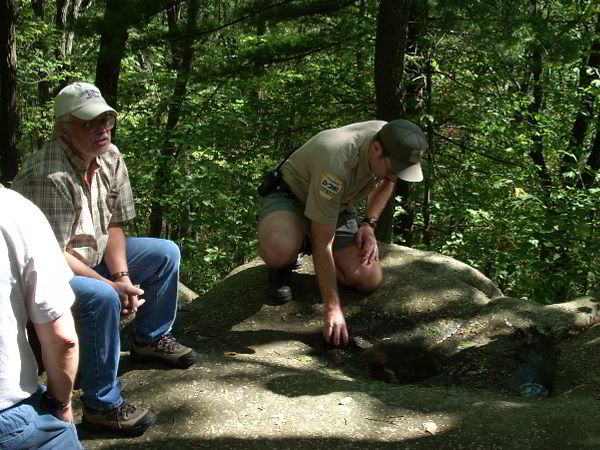|
==============================================================================
TOPIC: Archaic Grinding Holes, Cook Forest State park, PA
http://groups.google.com/group/entstrees/browse_thread/thread/3355a925aff32f39?hl=en
==============================================================================
== 1 of 4 ==
Date: Sun, Aug 31 2008 2:43 pm
From: "Edward Forrest Frank"

The people in the photograph are Dale Luthringer and Ken Burkett, a
local archaeologist who gave the tour.
Yesterday I participated in a short walk/program at Cook Forest
State Park, PA looking at some of the signs of utilization of the
area by Native Americans some 5,000 years ago in the archaic period.
The location is on a relative dry ridge top dominated by a forest of
Chestnut Oak. some white pine, eastern hemlock, and scattered yellow
birch. The understory included great rhododendron, mountain laurel,
ad some blueberries. The southern side of the ridge faced the
Clarion River and was rimmed in areas by sandstone bluffs to about
30 feet high atop the slope leading to the river below. The area was
utilized by a nomadic hunter gatherer culture who would visit this
area in the fall because of a large mast of acorns and chestnuts.
Today the primary oak present is chestnut oak, and there is a good
chance that this species was present at that time as well, since it
tends to grow well in these drier ridge top setting. American
chestnut may also have been a major part of the ancient canopy. In
the 1930's an exotic blight drove the species to effective
extinction across the eastern United States. Trees can still be
found sprouting from 80 year old root clumps, but these rarely grow
large enough to produce nuts before succumbing to the still virulent
virus. Those that do produce, generally form nuts that are not
viable and there is no know native reproducing population left
across the Appalachians and surrounding areas. At one time American
chestnuts formed as much as 90% of the basal area of forests in
parts of north central PA.
The signs of utilization are obvious if you know what you are look
at. Near the edge of the cliff tops are round grinding holes in the
rock. The people would gather and process the nuts from the
surrounding areas and brush the detritus off the edge. Acorns can be
eaten, but require processing. First the acorn must be cracked open.
Stone tools consisting of a small hole in a rock were used to
expedite this process. An acorn would be placed in the hole ad
whacked with a rock cracking the shell, without destroying the meat
inside. Different sized holes were used for different sized acorns.
Acorns are high in tannic acid. The acorns or acorn meal must be
soaked in water to remove the tannin to make them palpable. The
result is high in nutrition value and here the acorns were easy to
collect. The grinding hole surfaces have undergone weathering in the
intervening 5,000 years and there are surely many more covered by
leaf detritus.
At the base of the cliffs are frequent overhangs or chamber-like
rock openings served as campsites to get out of the rain or to
reflect the heat from fires in the chilling late fall evenings.
There have not been any formal excavations at the area because of
not wanting to destroy the buried campsites, and the large number of
visitors to the immediate area would hamper or ruin the excavation
process. The peoples visiting this area predate the history of any
of the modern tribes known to inhabit the region during the last
thousand years, and little is known about them besides the stone
artifacts that have survived the intervening years. Bone, wood, and
softer materials utilized by the people have long since been lost to
the acid soil and the elements. It is quite likely that these
features are present in some of the forests you explore, but perhaps
have not realized what they were. An interesting afternoon.
Ed Frank
== 2 of 4 ==
Date: Sun, Aug 31 2008 3:28 pm
From: Larry
Ed, Interesting report. We had many shell middens down this way,
most are gone now. I really enjoy reading about the Native
Americans.
So much of their history has been lost. To bad, we could have
learned
so much from them. Larry
== 4 of 4 ==
Date: Sun, Aug 31 2008 8:07 pm
From: DON BERTOLETTE
Ed-
We share a fascination!
When I was in Kentucky awhile back, my job took me into the
backwoods alot...what you referred to in "At the base of the
cliffs are frequent overhangs or chamber-like rock openings served
as campsites to get out of the rain or to reflect the heat from
fires in the chilling late fall evenings", were known as 'rock
houses', and one of the adjacent counties was called Rockcastle
county...in SE Kentucky, these were most often in the sandstone that
was immediately under a limestone cap...sometimes in concert with
coal seams...my best fossil find was in these associations...a giant
equisetum (horsetail) with about a 6" dbh, with exquisite
detail.
-DonRB
|